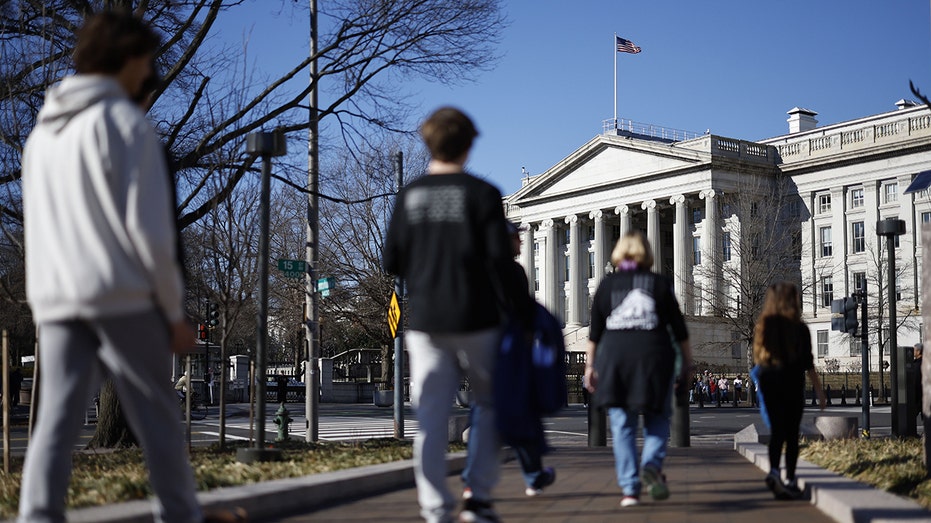Fed pauses rate hikes for first time in 15 months but hints at future increases
Fed skips interest rate hike after inflation eased in May
WATCH LIVE: Federal Reserve Chair Jerome Powell holds a press conference
The chairman discusses the U.S. central bank's decision on interest rates and its fight against inflation.
The Federal Reserve on Wednesday held interest rates steady for the first time in 15 months, pausing its aggressive tightening campaign to assess how the economy is faring in the face of higher borrowing costs.
The widely expected and unanimous decision left interest rates at a range of 5% to 5.25%, the highest level since 2007. But policymakers also left the door open to additional rate increases this year.
"Holding the target range steady at this meeting allows the committee to assess additional information and its implications for monetary policy," the Federal Open Market Committee said in a post-meeting statement. The Fed's next meeting is set for July 25-26.
New economic projections laid out after the meeting show that a majority of Fed officials who participated in the meeting expect rates to rise to 5.6% by the end of 2023, suggesting two more quarter-point increases this year.
A FED PAUSE LIKELY WON'T HELP STRUGGLING CONSUMERS
The central bank previously projected a peak rate of 5.1%, indicating that policymakers believe there is more work to be done to wrangle inflation under control.
Twelve of the 18 policymakers predicted at least two more quarter-point rate hikes, while four favored only one more hike. Just two officials supported keeping rates unchanged.
Stocks slumped following the surprisingly hawkish projections, with the Dow Jones Industrial Average shedding more than 250 points.
| Ticker | Security | Last | Change | Change % |
|---|---|---|---|---|
| I:DJI | DOW JONES AVERAGES | 49077.23 | +588.64 | +1.21% |
| I:COMP | NASDAQ COMPOSITE INDEX | 23224.824614 | +270.50 | +1.18% |
| SP500 | S&P 500 | 6875.62 | +78.76 | +1.16% |
Chairman Jerome Powell stressed during the post-meeting press conference in Washington that "a decision has not been made" about a rate increase in July and said he expects it will be a "live meeting."
"The main issue that we're focused on now is determining the extent of additional policy firming that may be needed to return inflation to 2% over time," Powell told reporters. "It may make sense to move rates higher, but at a more moderate pace. I want to stress one more thing: The decision the committee made today was only about this meeting. We didn't make any decision about going forward, including what would happen at the next meeting."
The quarterly forecasts indicate the U.S. central bank will not cut interest rates until 2024, to a rate of about 4.6%.

Federal Reserve Board Chair Jerome Powell speaks during a news conference at the Federal Reserve in Washington, D.C., on May 3, 2023. (Saul Loeb/AFP via Getty Images / Getty Images)
The decision comes one day after the Labor Department reported the consumer price index, a key measure of inflation, rose 4% in May from the previous year, the smallest increase in more than two years. While that is down from a peak of 9.1% hit last summer, it remains about twice the Fed's target 2% rate.
Other parts of the report also pointed to a slower retreat for inflation. Core prices, which exclude the more volatile measurements of food and energy, climbed 0.4%, or 5.3% annually.
"We don't think we're there with inflation yet," Powell said. "If you look at the full range of inflation data, particularly the core data, you just aren't seeing a lot of progress over the past year."
CLICK HERE TO READ MORE ON FOX BUSINESS
Policymakers have raised interest rates sharply over the past year, approving 10 straight rate hikes in hopes of crushing inflation and cooling the economy. In the span of just one year, interest rates surged from near zero to above 5%, the fastest pace of tightening since the 1980s.
Hiking interest rates tends to create higher rates on consumer and business loans, which then slows the economy by forcing employers to cut back on spending. Higher rates have helped push the average rate on 30-year mortgages above 7% for the first time in years. Borrowing costs for everything from home equity lines of credit, auto loans and credit cards have also spiked.

Pedestrians walk near the U.S. Treasury building in Washington, D.C., on Dec. 30, 2022. (Ting Shen/Bloomberg via Getty Images / Getty Images)
Despite the rapid increase in rates, the economy has proven surprisingly resilient.
The labor market is continuing to chug along at a healthy pace, with employers adding 339,000 new workers in May. Job openings remain high, although the unemployment rate recently ticked up to 3.7% from 3.4%, a half-century low.
GET FOX BUSINESS ON THE GO BY CLICKING HERE
The fresh forecasts laid out Wednesday illustrate that most central bankers anticipate the jobless rate will inch higher this year to 4.1%, although not as high as their previous 4.5% estimate. Officials predict that more Americans will be out of a job next year, when the unemployment rate is expected to hit 4.5%. That is also down from the 4.6% policymakers predicted in March.





















